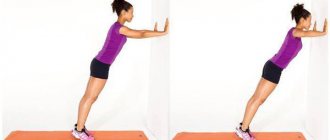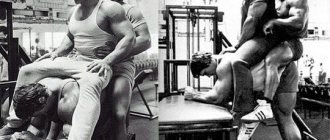Many of us remember that rope climbing was one of the practices in physical education classes. But today, not every adult, much less a child, masters this generally necessary climbing technique. But in vain. Such climbing is not only a fascinating activity that brings positive emotions, but also a useful practice: it trains agility, physical strength, develops the vestibular apparatus and general coordination of movements. Today we are in a hurry to tell you how to learn to climb a rope. Let's start with preparation.
Kinds
using your feet
without the help of legs
But before I further explain the differences between these types, let’s look at the criteria that apply to lifting in CrossFit training.
The starting position (unless specifically discussed) is standing on the floor.
We grab the rope as high as possible, then begin to rise to a given height using one of the types of lifting.
At the top point, you need to mark (fix) the rise - touch the rope fastening with your hand or something similar.
Having fixed your rise, you need to go back down to the floor to the starting position.
Using your legs to climb a rope allows you to spend virtually no effort when climbing, and if you add the correct execution technique to this, you can reach the top point in a couple of movements.
The essence of this lifting technique is to hold the rope with your hands and place your feet on the rope as high as possible, and for this you need to strongly pull your knees towards your stomach.
It is also necessary to place your feet on the rope “as if” but correctly. Look at the image below, it shows the correct placement of the legs - one covering the other. With this position, the hands practically do not get tired. Therefore, if the CrossFit complex does not specifically discuss the type of rope climb, then you should only climb in this way.
The second option requires good development of strength qualities, because you will have to rise without the help of your legs. They can just dangle or you can hold them with a corner (which is more difficult), the point is they remain alone in the lifting, they do not participate. You will have nothing to rely on.
We grab the rope with one of our hands as high as possible.
We raise our legs to the corner position (or like mine)
We pull our body towards the outstretched arm.
We intercept again only with the other hand
And again we pull ourselves up.
This is the correct technique for climbing a rope without using your legs. If you try to grab the rope with your hands without pulling yourself up, you will spend a lot of energy, and the effect of such a lift will be zero.
In addition, I would like to note that during the ascent there is no such theme - like I rose a little, then put my feet down (to rest), rested and then climbed again.
In CrossFit this would be considered norep.
Regarding the descent down - since in CrossFit almost everything is done for a while, it is also necessary to descend as quickly as possible. Just don’t jump down from the top point! This is life-threatening.
You wrap your legs around the rope, go down a little - to a safe height for jumping, and from this height you jump down. This is the best option to save time on the descent and not get killed.
Advice from an expert
For those who are interested in learning how to climb a rope, we present advice from M. Bondi (Guinness Book of Records record holder in rope climbing):
- In the starting position, place your hands shoulder-width apart and bend your knees slightly.
- Depending on whether you are right-handed or left-handed, wrap one hand around the rope as high as you can.
- Prepare for the jerk by bracing your core and squeezing your shoulders.
- Pushing off the floor with the foot opposite your hand, make a sharp movement, as if you were punching someone in the gut.
- When jerking, your gaze should be directed upward so that with your second hand you catch not the air, but the rope.
- It is important to grab as high as possible. However, in the beginning you can also take small “steps” with your hands.
- In further progress along the rope, it is important to catch the rhythm: extend your arm - grab it - pull yourself up - make a new jerk.
- At first it will be difficult for you to rise on your hands alone - actively help yourself with your legs. Raising your knees, make a cross lock: you need to pass the rope under one foot and over the other. Now you can lean on this “step”, carefully moving your hands up.
- It's a big mistake to hang on a tightrope. Your hips should fit snugly against it.
- Don't swing your arms wide. They should be as close to the rope as possible.
- When you go down, under no circumstances slide down the rope, you will simply wear your palms down to the ground. You need to move, alternately moving your arms (and legs, if it’s hard for you to go down without them).
How to teach a child?
How can a girl or boy learn to climb a rope? You can prepare your child as follows:
- The first step is to teach the young athlete to simply hang on the rope for as long as possible.
- Next, lightly swing the rope over the mats - the baby should be able to hold on to it.
- The next stage is to invite the child to swing the rope himself using his body movements, without touching the floor or walls.
- The last preparatory stage will be training leg clamps - this is best done with a gymnastic stick or pole. The child must learn to perform the correct grip: one foot is adjacent to the sports equipment with its front part, the second goes around it with the inside, closing the cross.
Now you just need to turn to teaching a boy or girl climbing techniques.
Preparatory exercises and periodic training will help both adults and children to quickly learn how to climb a rope.
It is important to move consistently from simple to complex, not to be lazy, work on mistakes and consolidate the result
Imitating the dexterous Mowgli or the nimble Tarzan, the child tries to master the “home vine” - the rope with which his sports complex is equipped. Book and cartoon characters fearlessly cut through the expanses of the jungle on long vines, and the child strives to master all possible tricks on this interesting sports equipment. Rope exercises allow children to become strong and resilient, like their favorite heroes, to whom wild nature gave strength, agility and beauty.
The gymnastic rope is an interesting element of the game, which also brings benefits for health and physical development. Children enjoy hanging, swinging and spinning on the rope.
Lifting and pulling up on a rope perfectly strengthens the muscles of the arms, legs, back and abs. The rope perfectly develops the vestibular apparatus. In addition to the fact that rope exercises have a positive effect on health, they always bring children a lot of positive emotions and joy.
It will be easier for a child to learn to climb a rope if several knots are tied on the rope at certain intervals.
How to learn to climb a rope?
To master the skill and achieve the agility of the jungle inhabitants, you need to train. You need to start with introductory exercises:
- How to climb a rope? The child sits down by the rope and grabs it with his hands at chest level and rises up, alternately intercepting the rope with his hands.
- The same exercise must be performed from a squat position;
- A similar exercise in which you need to hold on to the rope with straight arms above your head;
- Repeat the previous exercise, while holding the rope at chest level and raising your legs;
- The baby holds on with an arbitrary grip, swinging on a rope;
- Hold yourself freely and try to raise your legs to a hanging position while lying down;
- The child holds on to the rope, stepping with his feet in a hanging position, lying forward, backward, in a circle, etc.
Rope climbing training contains similar building exercises for the legs.
- How to sit on a rope? Sitting on a bench next to a hanging rope, you need to grab it with the soles of your feet and spread your knees to the sides;
- Repeat the exercise, only holding the rope with your hands;
- Holding the rope with your hands and grabbing it with the soles of your feet, you need to rise above the bench.
Grabbing the rope with your feet is more difficult, so it is necessary to perform approach exercises on the rope:
- The child sits on a bench, holding a gymnastic stick vertically in his hands. The foot of the right foot should be turned with the toe inward and applied with the outer side to the stick, and the foot of the left foot should be turned with the toe outward and pressed with the right hand to the stick on the other side - hold the stick with the feet;
- Repeat the exercise while sitting on a bench and holding on to the rope.
Now you need to master the technique of climbing a rope from a hanging position while standing on straight arms in three steps.
The first way to climb a rope: bend your legs and pull them higher, grab the rope with the outer sides of your feet and knees, while bending your arms slightly.
The second method teaches how to climb a rope correctly: resting your feet on the rope, you must straighten your legs and bend your arms without moving them.
The third way to climb a rope from a hanging position: grab the rope with straight legs and alternately grab your hands as high as possible.
Then all three methods of teaching how to climb a rope are repeated. During the descent, the rope climbing technique is performed in the reverse order: first, the arms are intercepted lower, the legs are straight, and then the legs are bent and the arms are straightened. You can't get off the rope, you can go down from it!
- Methods of rope climbing.
- What are the benefits of doing this exercise?
- Rope climbing techniques.
- Typical beginner mistakes.
- CrossFit complexes containing this exercise.
We teach our children to master the “peaks”
In order to interest your child in exercises, you should turn on your imagination and turn the exercise process into an exciting adventure. Invite the baby to swing on the harness like a monkey grasping a vine. This is how the baby will learn to hang on a gymnastic apparatus. To master more complex exercises, the child needs to grasp the rope with his legs and arms, while his hands should be at chest level. As for the legs, one should be adjacent to the projectile, and the second should go around it from the other side and thus close the grip.
Free climbing free climbing
The “cleanest”, most common, classic type of climbing is climbing using the strength of your arms and legs along the natural structure of the rock []. Usually this means natural belay - there are no fixed belay points in the rock. The term “free climbing” does not carry information about the presence or absence of insurance, but only about the method of movement on the rock.
Subtypes of free climbing - “solo” - the climber climbs alone, but with belay using a special belay device, the most famous is Silent Partner. Or without insurance (free solo).
Further, depending on the type of equipment used, free climbing is divided into sports and mountaineering (in the Soviet school) and sports and traditional (trad climbing) in the Western school.
In our terminology this is mountaineering, in Western terminology it can be trad, trad-multipitch or alpine climbing
Related materials
Interesting articles
- Does chewing gum help you get snow-white teeth?
- How to get enough sleep if you are over 40?
- The Voice of Man: 13 Little-Known Facts
- What people regret on their deathbed: revelations from nurses
- What does your face shape say about you?
- What happens to children who are yelled at all the time?
- 6 Scenes With Really Drunk Actors
- 35 wisest Jewish sayings
- Why should you have sex as often as possible?
- Why do women experience orgasm?
- Super healthy drink
- Jamie Oliver's idea of how to fight sugar addiction
- Why do you need to do push-ups every day?
- Scientists have discovered a secret message in the eyes of the Mona Lisa
Aid climbing using artificial support points AID climbing
This is the opposite of free climbing - a man-made type of climbing that uses special devices to climb the rock []. The leader in aid climbing stands on ladders made from slings or tied from a rope, connected by carabiners to points of support or belay (bookmarks, friends, various hooks, etc.). Aid is used where the climber cannot or does not want to free climb.
The trend in the development of extremely difficult technical mountaineering ascents in recent decades is the passage by free climbing of routes that were previously considered impassable or first climbed using aid technology. However, there are still quite a lot of lines that are unlikely to ever be free climbed (very narrow cracks, lack of terrain for climbing, etc.).
Aid (artificial support points) climbing: using ladders and various embedded elements and hooks as points of support and insurance. Photo -
Aid climbing guru Chris McNamara shows movement techniques in aid climbing
What are the benefits of pull-ups?
First of all, this is a bluff for working muscles. Pull-ups on a horizontal bar are an exercise that is symmetrical from the base, but here the movement is carried out unilaterally and has a completely different specificity. Rising up on one hand is, of course, a more difficult task, in addition, it is an element of stabilization, since the rope is in motion, and with it our body, and the traction is rigid and allows us to maintain the same body position. This is an additional element that is a challenge and provides new incentives. In the context of increasing the overall effectiveness and performance of the classic pull-up, the cable pull-up can be an excellent tool to supplement your training. If we train our muscles for too long with the same exercises, over time they get used to it and no longer want to grow. By doing this exercise you will put a new load on your muscles that is not yet familiar to your body and can make your muscles grow again. Stimulating the muscle in a different way, strengthening other fibers, will have a beneficial effect on fullness and may help reach the barrier.
How to do pull-ups on a rope?
It may look quite simple, but people who are approaching a rope for the first time will have difficulty holding the rope itself. The second obstacle will be the lack of skills in coordinating the movements of the arms and legs. The third is the lack of strength in the hands (although they are not the main lever here).
First of all, there is no need to despair, because it is rare for anyone to succeed the first time.
The most important thing is to learn to keep balance (so as not to swing too much on the rope) - if our body does not dangle much on the horizontal bar, then on the rope the vibration will be felt much more strongly. When we want to pull ourselves up, we must hold our body with one hand, and with the other, to move higher and take a step, grab hold of it. Although, it is more difficult to climb up on one hand, but this work is done alternately, and with each movement, one side rests. An additional relief is the correct position of the legs on the rope, when we are on the line, on the contrary, stand, giving rest to the shoulders. One foot goes under the rope, the other stands on it and, thus, I have a small “platform”.
How to get down?
I managed to climb – great!!! But what next? This can be a challenge, and certainly no one wants to jump from a height or hurt their hands on a rope. It is best to remain calm and descend the same way, in reverse order as when lifting your arms through your arms, gradually lowering your body down.
Summarize:
Cable pull-ups have many benefits and are a great variation in spinal training, an alternative to pull-ups. You can also include this exercise for training the back muscles as an element that provides other stimuli to the back muscles.
Pull-up on the bar with weight
Link for your site:
Show article to a friend:
Typical beginner mistakes
Listed below are the main mistakes that inexperienced athletes make when studying this element. They do not contain anything particularly dangerous, but deviations from the correct technique will significantly complicate your learning of this already difficult exercise. These errors are not so much technical errors as deviations from the generally accepted rules of rope climbing, so I do not recommend ignoring this information.
- The athlete grasps the rope not with his feet, but with his hips. You are unlikely to be able to squeeze the rope with your thighs with enough force to balance comfortably. Use only the above method - the toe of one foot and the heel of the other foot.
- Do not use gloves while climbing a rope - this will not protect your skin from the appearance of calluses, do not believe this myth. In addition, when using gloves, your grip strength will develop much more slowly.
- Do not jump off the rope , especially if it is fixed at a high height. This is perhaps the only moment where you can get seriously injured. If you land poorly, you can damage your ankle or injure the metatarsal bones of your foot, which can knock you out of the training process for several months.
- Don't slide down the rope. Yes, of course, it’s faster this way, but the pain on the skin of your palms is unlikely to allow you to do a few more approaches.
- Don't forget to use magnesium , this will improve the grip of your palms on the rope and reduce the risk of unclenching your palms at the most inopportune moment.
Categories
Planning
- Conception
- Infertility
- Preparing for pregnancy
- Late pregnancy
Pregnancy
- Examinations and procedures
- Fitness for pregnant women
- Personal care
- Lifestyle during pregnancy
- Nutrition and pregnancy
Childbirth
- Preparing for childbirth
- Recovery after childbirth
- Life after childbirth
Care and education
- Newborn care
- From 1 year to 3 years
- From 3 to 6 years
- From 6 to 11 years
- Education in other countries
Feeding
- Breast-feeding
- Artificial feeding
- Lure
- Baby food
Diseases
- Diseases during pregnancy
- Children's health
When copying materials, a link to the “Encyclopedia of Motherhood” is MANDATORY!
- About the site
- Rules
- Feedback
- Catalog of houses
- Children's website directory
Rope climbing techniques
There are several types of rope climbing techniques. Let's look at each of them in detail:
Rope climbing in three steps
- Starting position: the athlete holds the rope tightly with his hands and feet (the toe of one foot and the heel of the other foot).
- Push off the rope with your legs, bend them and grab the rope a little higher in the same way.
- Without letting go of the rope with your feet, alternately move your hands higher and repeat the movement.
Rope climbing in two steps
There are two ways to climb a rope in two steps.
First way:
- Starting position: one hand is fully straightened and clasps the rope above head level, the other hand is held at chin level. We grab the rope with our feet with the toe of one foot and the heel of the other.
- We push off with our feet and try to pull ourselves up on the arm that is located higher.
- With the other hand we intercept the rope higher, at the same time we pull up our legs and take the starting position.
Second way:
- Starting position: hands are located at the same level just above the level of the head, one is located immediately below the other. We hold the rope with our feet in the same way - toe and heel.
- Push off with your legs, grab the rope a little higher, pull yourself up, intercept the rope and hang with straight arms.
Preparatory exercises
Before you learn how to climb a rope from scratch, you need to prepare your body for a new load:
- First of all, strengthen your hands by exercising with a regular wrist expander.
- The following exercise will help strengthen the muscles of your arms and legs: hang on a rope while holding it with your legs crossed below the knees. During the exercise, you need to alternately move your arms up and down.
- Grasp the rope with your hands as high as possible and hang on it. Don't help yourself with your feet. Your goal is to hang as long as possible. Once you can handle this exercise with ease, try doing pull-ups without using your legs.











